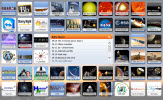April 2019
This month the morning planet arrangement makes it easy to visualize the plane of the ecliptic.
Mercury moves further into the morning skies and its greatest western elongation at mid-month. Venus contines as the brightest object in the morning skies other than the Moon, but is low over the southeast horizon at sunrise. Mars is visible over the southwestern horizon at sunset and compares nicel with the reddish color of the star Aldebaran a few degrees away. Jupiter rises around midnight and is visible for the rest of the night hours. Jupiter begins its retrograde motion this month. Saturn rises a couple of hours after Jupiter and Saturn also begins its retrograde motion at the end of the month.
Click here for the month at a glance calendar.

Jupiter and Saturn Begin to Retrograde this month.
Mercury should be visible over the southeastern horizon around sunrise local time. It will gradually be rising earlier then the Sun, at least until Mercury reaches its greatest western elongation at 28o on the 11th.
Venus continues to outshine all other pre-dawn celestial objects except for the Moon. However as days pass Venus is gradually catching up with the Sun and rising clser to the time of sunrise, thus appearing lower over the horizon each day.
Mars is easily seen over the southwestern horizon after sunset and is within about 7o from the reddish star Aldebaran in Taurus the Bull.
Dwarf Planet Ceres is a few degrees west, to the right, from Jupiter, and begins its retrograde motion this month. Ceres is also gaining in absolute magnitude as it brightens from 7.16 to 6.86 this month.
Jupiter rises around local time for midnight and will remain visible the remainder of the night hours. Jupiter begins its retrograde motion this month.
Saturn rises a couple of hours after Jupiter and like Jupiter will be visible the remainder of the night hours, and will also be starting its retrograde motion at the end of the month.















 Above the Solar System at 10 day Intervals
Above the Solar System at 10 day Intervals


 Lee's Summit, MO
Lee's Summit, MO 